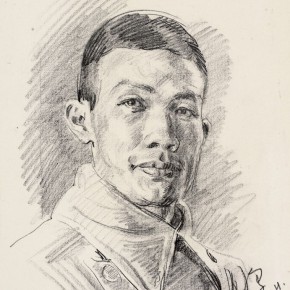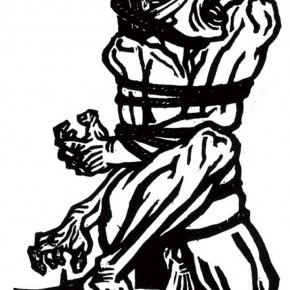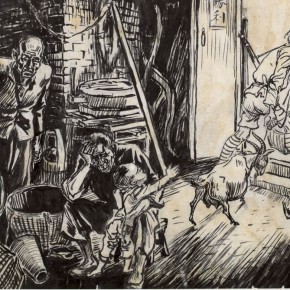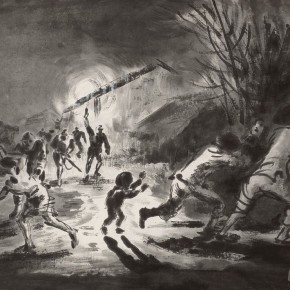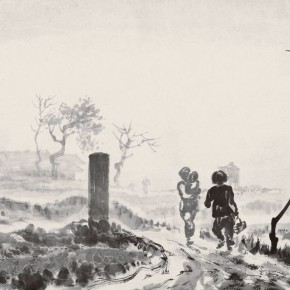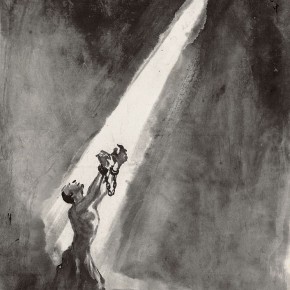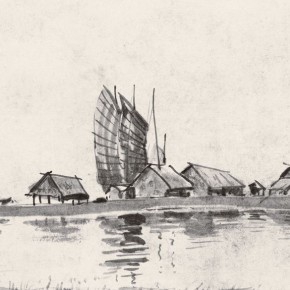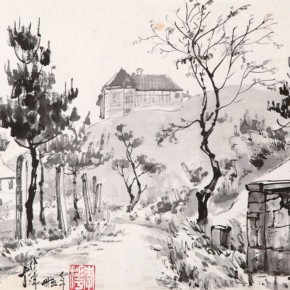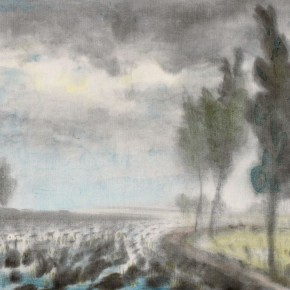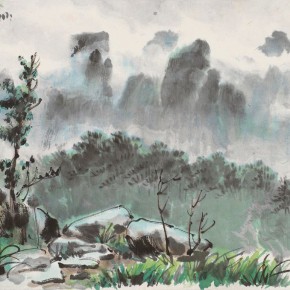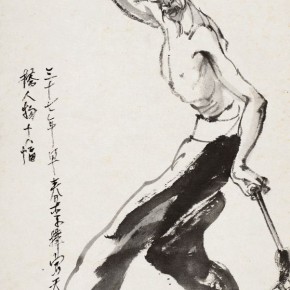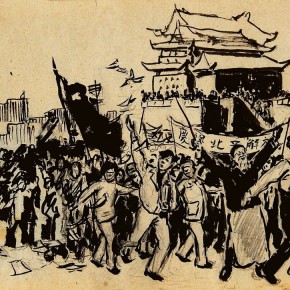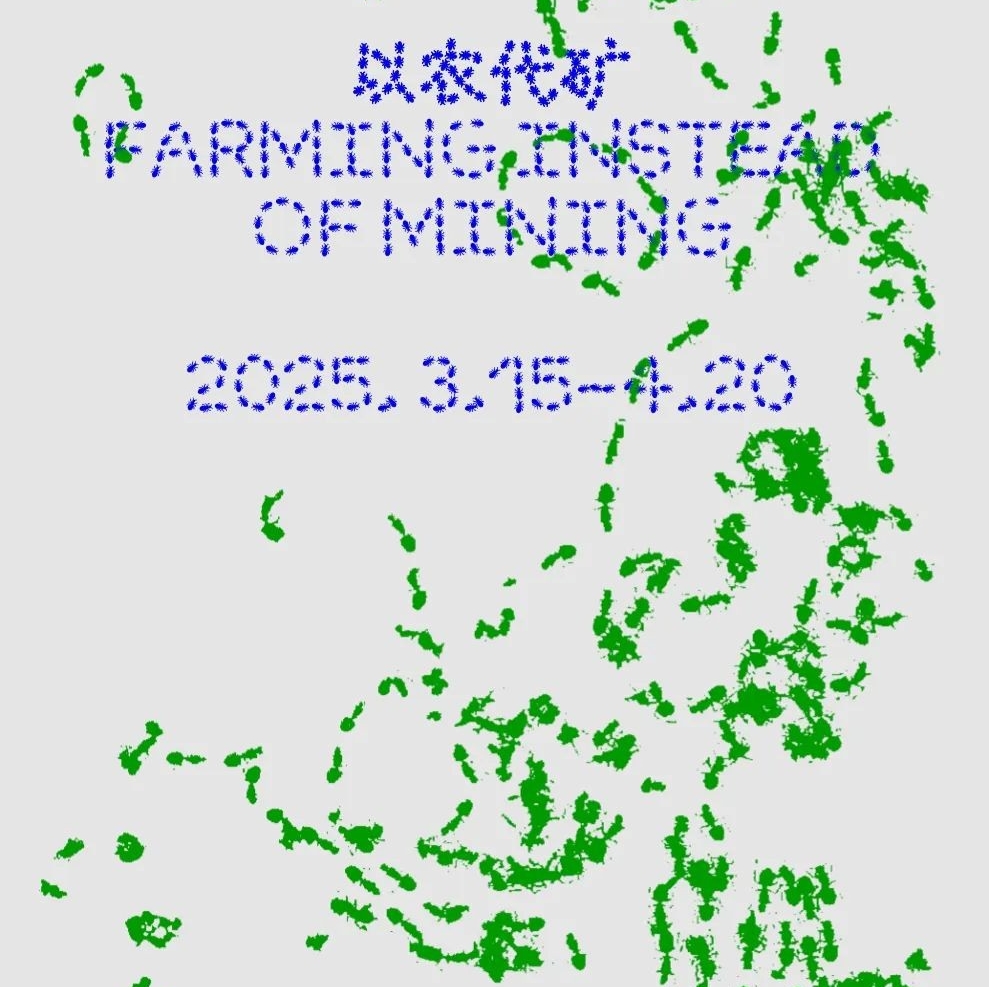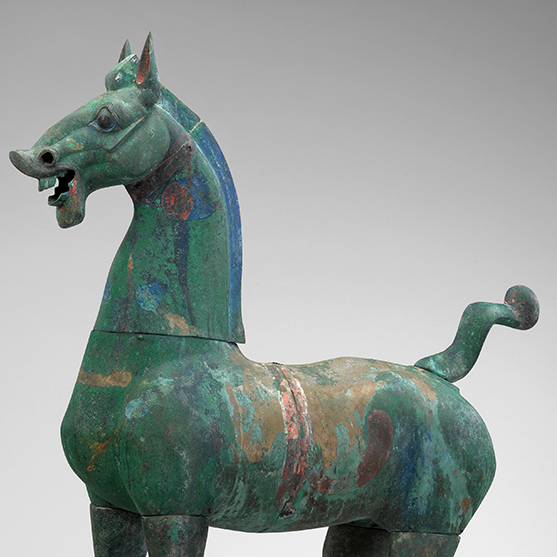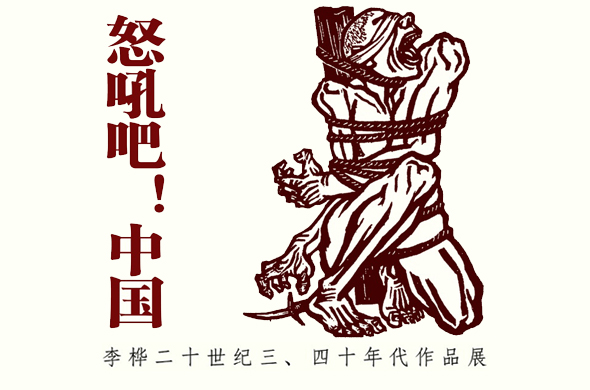
Jointly curated and hosted by China Artists Association, CAFA and Wuhan Art Museum, “Roar! China”: Li Hua’s Works of the 1930s and 1940s kicked off at Wuhan Art Museum on November 27, to comprehensively present more than 70 woodcuts, ink paintings, drawings and sketches created by Li Hua before the founding of new China, and is combined with the related literature and historical photos to restore in a three-dimensionally way the eventful years of Li Hua during the periods of the Anti-Japanese War and Liberation War. The exhibition continues to December 20.
The powerful symbolic work entitled “Roar! China” is a woodcut created by Li Hua in 1935. The strong young man tied to the wooden stake, whose eyes were blindfolded is a symbol of the fate of the Chinese nation. But he is opening his mouth and roaring; one hand tries to reach to get the dagger and once he manages, he could cut off all the bounded ropes for liberation. Strong black and white lines depicted the plight of the nation in peril and the people resolutely resisted, this painting is like Lu Xun’s “Roar” showcasing the strong awareness of the unexpected development for national survival, and more vividly called all countrymen’s awakening and struggle. Now this small woodcut has become a symbol of Chinese Anti-Japanese War, and is also one of the classics of Chinese modern art history.
From “Paris School” to “New Woodcut”
Li Hua graduated from the Municipal Guangzhou Art School in 1926 and was interested in the worldwide fashionable Paris School at that time, he set his sights on becoming an oil painter, and then Li went to Japan to study fine arts at “Kawabata Art School” in Tokyo. But when he studied in the school for only a year, the Mukden Incident that shocked China and the world broke out, a strong patriotic spirit made Li Hua demonstrate and parade to protest at the Japanese military aggression against China, then he resolutely decided to give up his studies, and then returned to China. Li Hua started to rethink the fundamental differences between Chinese and western art, determined to give up the pursuit of western modern art, focusing on the real life of the motherland. Influenced by Lu Xun, he began to learn woodcutting art, and founded the Modern Woodcut Society at the Guangzhou Art School, where he worked, through pieces of solid and powerful prints and organised actions to greatly promote the new woodcut movement in the Guangdong region.
From a Young Military Officer to the Democracy Fighter
After the outbreak of the Anti-Japanese War, the situation was pressing. Li Hua, together with his knives and brushes went to the frontline of the Anti-Japanese War, became a civilian official in the third war zone. He joined the army for 8 years, he had never stopped the creation of woodcuts and also actively organized and took part in the related activities in making the new woodcuts. The creation of this period has a broader vision of theme than the previous ones in this period and it presents many ink paintings in the exhibition, including the works that depict the Anti-Japanese War scene, and a large number of works to depict the subjects of social life and the natural scenery. He used the brush to record people’s hardships and misfortune brought by the war, while using works to express the deep love for beautiful mountains and rivers of the motherland.
After the end of Anti-Japanese War, Li Hua left the army and went to Shanghai, actively joined in the struggle for democracy and the campaign against civil war. This period is also the prosperous period of Li Hua’s art career, continuously creating a large number of antagonistic print works, such as “Raging Tide” group paintings, “After Conscription and Imposed Grain Levies”, “Help Him Come into the House as Fast as Possible”.
With the strong spirit of patriotism and compassionate feelings, Li Hua threw himself into revolutionary propaganda to save the nation from subjugation and it made no difference if it was the Anti-Japanese War or the Liberation War, his art creation tried to seek a combination between real life and revolutionary struggle, the use of his own unique art language to write the voice of the Chinese nation that fought against the oppression and pursued peace. On the occasion of the commemorating of the 70th anniversary of the victory of the Anti-Japanese War & the victory of the World over the Anti-Fascist War, it is undoubtedly of a special historical significance to comprehensively review Li Hua’s works of the 1930s and the 1940s.
About the exhibition
“Roar! China”: Li Hua’s Works of the 1930s and 1940sDuration: November 27 - December 20, 2015
Venue: Wuhan Art Museum Hall 1, Hall 2
Hosts: China Artists Association, CAFA, Wuhan Art Museum
Producer: Fan Feng
Master Planning: Liu Yu
Curators: Li Kang, Xue Liang
Exhibition Coordinator: Zhang Wenbo
About the Artist
Li Hua (March 6, 1907 − May 5, 1994), a Chinese woodcut artist and communist known for his participation in left-wing activities, was born in Panyu, Guangdong. He graduated from the Municipal Guangzhou Art School in 1926 and remained there as a teacher. In 1930, Li went to Japan to study fine arts at “Kawabata Art School” in Tokyo. Li returned to Guangzhou in 1932, after the Mukden Incident broke out, and served once again as a teacher at the art school where he had studied. At that time, he began to learn woodcutting art. He was influenced by Lu Xun who regarded him as one of the most promising woodcut artists of his generation. In June 1934, Li founded the Modern Woodcut Society at the Guangzhou Art School with an initial membership of 27. He initiated and organized “China National Woodcutters Fighting Enemies Association” in 1938 and was elected as a member of the council. He produced many woodcuts to protest against the invasion by the Japanese army and the decaying government that was led by Chiang Kai-shek. One of Li's notable woodcut series was Raging Tide in 1947, when he taught at National Beiping Art School having been invited by Xu Beihong. In 1949, he became a professor of the Central Academy of Fine Arts (CAFA), and continued his artistic creations. He then became a professor, Head of the Department of Printmaking, CAFA, member of the national committee of China Federation of Literary and Art Circles. He was also a member of the council and advisor of China Artists Association, Chairman of China Woodcutters Association and the editor-in-chief of the magazine Woodcut. His representative works include “Roar! China”, “Raging Tide” group paintings, “Overpass Character”, etc. Publications include Twenty Lectures on the Rules of Fine Arts Creation, Chatting in the West Room, Theory and Practice of Woodcut, Research of Woodcut Technologies.
Courtesy of the artist and Wuhan Art Museum, translated by Chen Peihua and edited by Sue/CAFA ART INFO.


